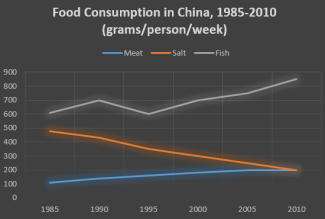The graph below shows the changes in food consumption by Chinese people between 1985 and 2010.
Summarise the information by selecting and reporting the main features, and make comparisons where relevant.

A glance at the graph given illustrates how people in China change their eating habits in meat, salt and fish during the period of 1985-2010.
In overall, whereas the consumption in fish and meat got increased over the years, salt usage suffered from a hard fall.
At the beginning in 1985, people consumed 600 grams of fish per person per week. After that, the number went up slightly by 100 grams to 700 grams 5 years later, just to suffer from a smooth decrease back to the same figure of 600 grams in 1995. From then on, more fish was consumed over the years, which pushed the number to over 800 grams in 2010.
Throughout the period of 26 years of surveying, the amount of salt and meat Chinese ate went through different patterns. Whereas in 1985, each person in China tended to eat around 500 grams of salt in a week, the figure then went through a gradual fall to only 200 grams in 2010. On the contrast, Chinese people tended to consume more and more meat over the years, from only 100 grams to 200 grams in 2010.

Transition Words or Phrases used:
if, so, then, whereas
Attributes: Values AverageValues Percentages(Values/AverageValues)% => Comments
Performance on Part of Speech:
To be verbs : 1.0 7.0 14% => More to be verbs wanted.
Auxiliary verbs: 0.0 1.00243902439 0% => OK
Conjunction : 4.0 6.8 59% => More conjunction wanted.
Relative clauses : 2.0 3.15609756098 63% => OK
Pronoun: 2.0 5.60731707317 36% => OK
Preposition: 47.0 33.7804878049 139% => OK
Nominalization: 1.0 3.97073170732 25% => More nominalizations (nouns with a suffix like: tion ment ence ance) wanted.
Performance on vocabulary words:
No of characters: 842.0 965.302439024 87% => OK
No of words: 190.0 196.424390244 97% => OK
Chars per words: 4.43157894737 4.92477711251 90% => OK
Fourth root words length: 3.71268753763 3.73543355544 99% => OK
Word Length SD: 2.09285818957 2.65546596893 79% => OK
Unique words: 95.0 106.607317073 89% => More unique words wanted.
Unique words percentage: 0.5 0.547539520022 91% => More unique words wanted or less content wanted.
syllable_count: 224.1 283.868780488 79% => OK
avg_syllables_per_word: 1.2 1.45097560976 83% => OK
A sentence (or a clause, phrase) starts by:
Pronoun: 0.0 1.53170731707 0% => OK
Interrogative: 0.0 0.114634146341 0% => OK
Article: 4.0 4.33902439024 92% => OK
Subordination: 1.0 1.07073170732 93% => OK
Conjunction: 0.0 0.482926829268 0% => OK
Preposition: 7.0 3.36585365854 208% => Less preposition wanted as sentence beginnings.
Performance on sentences:
How many sentences: 8.0 8.94146341463 89% => OK
Sentence length: 23.0 22.4926829268 102% => OK
Sentence length SD: 26.0 43.030603864 60% => OK
Chars per sentence: 105.25 112.824112599 93% => OK
Words per sentence: 23.75 22.9334400587 104% => OK
Discourse Markers: 2.625 5.23603664747 50% => More transition words/phrases wanted.
Paragraphs: 4.0 3.83414634146 104% => OK
Language errors: 0.0 1.69756097561 0% => OK
Sentences with positive sentiment : 1.0 3.70975609756 27% => More positive sentences wanted.
Sentences with negative sentiment : 2.0 1.13902439024 176% => OK
Sentences with neutral sentiment: 5.0 4.09268292683 122% => OK
What are sentences with positive/Negative/neutral sentiment?
Coherence and Cohesion:
Essay topic to essay body coherence: 0.0983573593649 0.215688989381 46% => OK
Sentence topic coherence: 0.0523550587078 0.103423049105 51% => OK
Sentence topic coherence SD: 0.0413880763745 0.0843802449381 49% => Sentences are similar to each other.
Paragraph topic coherence: 0.0723535272749 0.15604864568 46% => OK
Paragraph topic coherence SD: 0.0455745053812 0.0819641961636 56% => OK
Essay readability:
automated_readability_index: 11.3 13.2329268293 85% => Automated_readability_index is low.
flesch_reading_ease: 81.97 61.2550243902 134% => OK
smog_index: 3.1 6.51609756098 48% => Smog_index is low.
flesch_kincaid_grade: 7.5 10.3012195122 73% => OK
coleman_liau_index: 8.71 11.4140731707 76% => OK
dale_chall_readability_score: 6.94 8.06136585366 86% => OK
difficult_words: 26.0 40.7170731707 64% => More difficult words wanted.
linsear_write_formula: 9.0 11.4329268293 79% => OK
gunning_fog: 11.2 10.9970731707 102% => OK
text_standard: 9.0 11.0658536585 81% => OK
What are above readability scores?
---------------------
Rates: 61.797752809 out of 100
Scores by essay e-grader: 5.5 Out of 9
---------------------
Note: the e-grader does NOT examine the meaning of words and ideas. VIP users will receive further evaluations by advanced module of e-grader and human graders.